-Stage 4.1-
Geology Fun Facts
Below are some of the interesting and often misunderstood facts in geology (and geology related fields).
Question: Did dinosaurs eat grass?
There has been a continuous debate over the pictures showing dinosaurs eating grass and scientists frequently stating that it didn't happen because grass didn't evolve yet, or grasses during the Mesozoic (the Age of the Dinosaurs) were primitive. However, recent research has shown that there were more advanced grasses during the Mesozoic, perhaps even as far back as 100 million years ago (Ma). Non-avian dinosaurs first appear ~230 Ma and went extinct about 65/66 Ma, so they had access to grasses for about ~20% of their existence.
Topic: Dark Side of the Moon
Contrary to popular opinion, and a Pink Floyd album, there is no actual "dark side" of the moon. A "dark side" insinuates that the sun never reaches that side, which isn't true in the case of the moon. The moon, however, is tidally locked to the Earth. This means that the same side of the moon faces the Earth at all times. It is like the moon is being swung around the Earth on a string with the string attachment on the side of the Earth at all times. This has been known for a long time, and the side on the opposite side of the Earth has been known as the "dark side", otherwise known as the "unknown side". But this "dark side" does get light from the sun. When the moon is in New Moon phase, meaning it is completely dark in the sky, the moon's opposite side, the "dark side", is completely lit. The percentage of that "dark side" being lit is the opposite of our light side. As more of the Earth's side is lit, less of the "dark side" is.
Topic: Elemental Abundance
The abundance of the elements in the solar system generally decreases with increasing atomic number. Looking at the Periodic Table, Hydrogen (1) has the highest abundance and Helium (2) has the second. However, the third highest abundance is Oxygen down at number 8. The reason for this jump is that there is a stability problem with elements 3-5 (Lithium, Beryllium, and Boron), which causes these elements to have extremely low abundances. Odd atomic numbers also, generally, have lower abundances than neighboring even numbered elements. The result is that Carbon (6) and Oxygen (8) both are pretty close in atomic abundance, and are both greater than Nitrogen (7) in the middle of them.

Question: Are fossil fuels actually made of dinosaurs?
No! Despite the common misconception, most fossil fuels do not actually come from dinosaurs or fossils for that matter. Oil and natural gas formed mostly from bacteria that died and blanketed the bottom of the sea before being buried and “cooked” into the fossil fuels we all know and love. Coal on the other hand, does sort of come from fossils. Coal was formed in prehistoric swamps from plant matter that never biodegraded due to low oxygen content of swamps and preserved the organic matter to be “cooked” into coal.
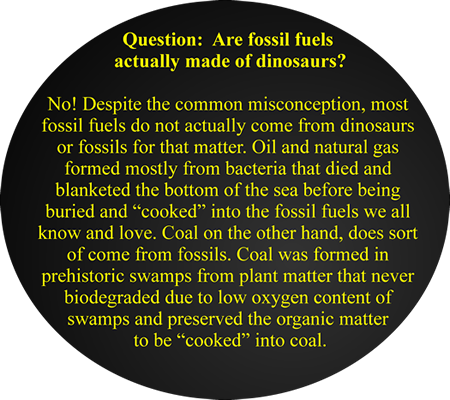
Question: What is the Earth’s most common mineral?
Looking at the bulk composition of the Earth, the most common mineral is a silicate mineral with a perovskite structure that dominates the lower mantle. This mineral has recently been named “bridgmanite”.
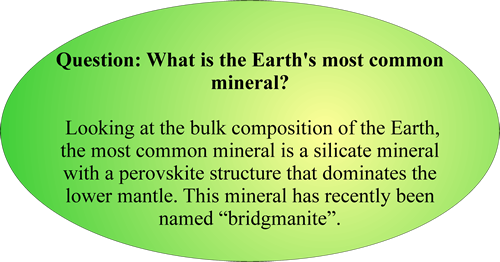
Myth: there’s plenty of water to go around.
Out of all the water on the Earth, 97.5% is salt water. This means it is not able to be consumed directly by humans. Of the remaining 2.5%, 70% of that is frozen in the icecaps, and most of the remaining 30% is in the soil and in deep groundwater deposits. So out of all of the water on Earth, <1% is available for human consumption (i.e. in rivers, streams, and shallow aquifers).
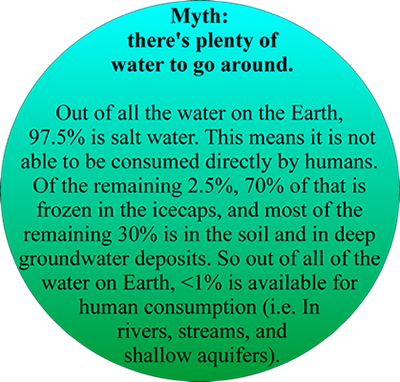
Topic: Deadly Volcanoes
Even though you can potentially outrun most of the eruptive materials from a volcano (if you need to) there are some that move extremely fast. The fastest volcanic eruptive materials are pyroclastic flows, which can move at speeds greater than 100 mph and reach temperatures greater than 800°F.

Question: Do the continents move at the same rate that fingernails grow?
The continents have been clocked at pretty accurate speeds using GPS. It is known that the plates move at speeds between 2 and 10 cm/yr. Fingernail growth on the other hand grows on average up to 4 cm per year. So, most plates do move at the speed of fingernail growth but some, like the Pacific Plate can move over twice as fast.
Myth: A comets tail points towards the sun.
A comet tail is only produced near a star (such as our sun). When the comet gets close enough to the sun, the solar winds push debris off of the comet, producing the tail. However, instead of following behind the comet, the tail always points away from the sun. So, if the comet is going towards the sun, the tail is behind it (as you would expect), but if the comet is going away from the sun, the tail is in front.
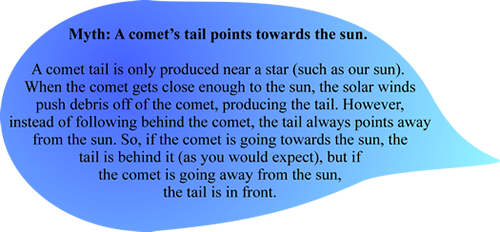
Myth: The Asteroid Belt was a planet that was ripped apart
Currently scientists believe that the Asteroid Belt, located between Jupiter and Mars, never actually formed into a planet. There is evidence though that a proto-planet did initially form but it never fully consolidated. The competing gravity wells from Jupiter and the sun were too great for one to finish forming.

Myth: My compass points to the North Pole
The Magnetic North Pole is not in the same location as the real North Pole. In actuality, it is located near Ellesmere Island in Canada. But on top of that, it has moved throughout history and is currently moving at about 40 miles per year. It even flips with the South Pole on a regular basis every ~0.8 million years.

Topic: Dwarf Planets
When Pluto was demoted from a planet, there was a new category created called “Dwarf Planet”. Unlike a planet, a dwarf planet does not need to clear its orbital neighborhood. In addition to Pluto there were four other dwarf planets identified within about two years. One is Ceres, the largest asteroid in the Asteroid Belt between Mars and Jupiter. The others are in the Kuiper Belt or beyond, which is out beyond the orbit of Pluto. These are Eris, which is larger than Pluto, Haumea, and Makemake.

Topic: Compressed Graphite
When you think of it, there doesn’t seem to be any greater divide than between diamonds and graphite (the lead in your pencils) but in actuality they are both made of the same “stuff”. They are both are made up of carbon atoms, just in different configurations. If you were to place graphite under an extremely high pressure and heat it up to a high enough temperature, you could actually make your own diamonds!

Question: How Slow is “Slow as a Glacier”?
Even though glaciers are typically thought to move very slowly (think inches at most a year), in actuality they can move amazingly fast. Some glaciers in Greenland have been clocked at going 12,600 meters per year. That is about 1.4 m/hr or 4.7 ft/hr!

Topic: Supercontinents.
It is relatively well known that there was at least one supercontinent in our planet’s past - Pangaea. But in actuality there have been numerous instances of supercontinents during different time periods.
Pangea: ~300-~180 Ma (million years ago)
Rodinia: ~1000-~700 Ma
Columbia: ~1.65-~1.5 Ga (billion years ago)
Kenorland: ~2.5-~2.2 Ga
There are possibly even more supercontinents in our planet’s history, but those are not as well understood

Myth: Dinosaurs are Extinct.
While all non-avian dinosaurs are extinct, there is overwhelming evidence that birds are descendants of dinosaurs, making them dinosaurs themselves. So, the next time you eat a turkey or a chicken, you are eating a dinosaur.

Myth: Volcanoes grow slowly.
While often true in terms of human perception (not in geological terms) there are some notable exceptions. One of the fastest growing volcanoes in recorded history is a cinder cone that came up in a farmer’s field in Mexico. The volcano, Parícutin, grew over 336 meters in 1943 when it first appeared.
Myth: Pluto was stripped of planethood because people didn’t like it.
In reality, the reason Pluto got demoted is because the definition of a planet was not set until the International Astronomical Union (IAU) defined it in August 2006. In short, they stated that a planet:
1. Orbits the Sun
2. Is relatively round
3. Has cleared its orbital neighborhood
#3 is the reason Pluto was demoted. Pluto’s moon, Charon is about half the size of Pluto and does not orbit Pluto. Essentially, they orbit the same point in space making it more of a binary system and not a lone planet. So, by definition Pluto is not a lone object orbiting the sun and therefore is not a planet.
Moonquakes?
Even though the moon is technically “inactive” there is some shaking still going on. The epicenters range from 700 km below the surface to 20km below. And since the moon is so dry, they can keep going from 10 minutes up to several hours to fully stop. It’s like vibrating a tuning fork.
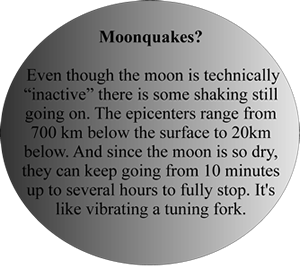
Early Life
The Phanerozoic Eon is the time period consisting of the last 540 million years and means “Visible life”. Although originally thought to correspond with the evolution of life it is now known to represent the evolution of hard parts (like shells). Life truly evolved over 3.2 Ga (billion years ago) and possibly even as early as 3.85 Ga.

What kind of waves are produced in an earthquake?
It is usually thought that there are only two main types of seismic (earthquake) waves. These are the Primary (P) Waves and the Secondary (S) Waves. But there is also a third main category called Surface Waves. These can be broken into 2 categories called Love Waves and Rayleigh Waves. Surface Waves produce the most shaking and the most damage of the land surface. Love Waves shake the ground back and forth while Rayleigh Waves shake it up and down.
Dense as a Rock?
Rocks are generally assumed to be hard, dense objects that would sink in water without a problem. But there are rocks out there that are not dense at all. The least dense rock is pumice, which is produced during a volcanic eruption when lava is blasted into the air and cools. As the lava cools it has a lot of air pockets, or pores, that produce enough buoyancy that pumice can actually float.
Geology in Art:
It is thought that the reason the sky is red in Edvard Munch’s “The Scream” is due to a volcanic sunset, which was caused by the eruption of Krakatoa in 1883.
Theory: Diamonds are older than the dinosaurs.
Actuality: The youngest naturally occurring diamond is over 900 million years old, while the earliest dinosaur is estimated to be less than 250 million years old.
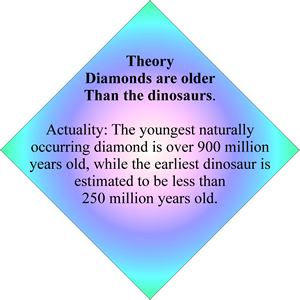
Question: What is the most common mineral in the crust and surface of the Earth?
Answer: Depending on how you look at it there are two possible minerals. Quartz is the most common mineral on the surface of the Earth, but Feldspar is the most common mineral in the crust. Feldspar though, is commonly considered a group of minerals, which includes Potassium-Feldspar and Plagioclase.
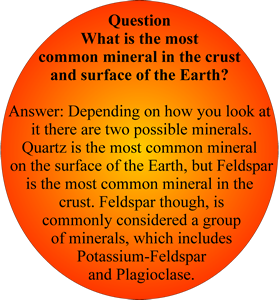
Theory: Ice is a Mineral.
Minerals are defined by being an inorganic, naturally forming, substance with a definite chemical composition, and usually a definite crystal structure. All of which ice satisfies. So, by definition, ice is a mineral. Just one with a significantly lower melting point than most people are usually accustomed to.

Theory: A diamonds is forever
Actuality: Diamonds are actually not forever. Since diamonds are formed at much higher pressures, they are unstable on the Earth’s surface and will eventually degrade into a stable form of carbon (graphite). But don’t worry, this won't happen for several million years.

Seismology
The study of earthquakes began in at least 350 BC when Aristotle noticed that soft grounds shake more than the hard rocky ground.
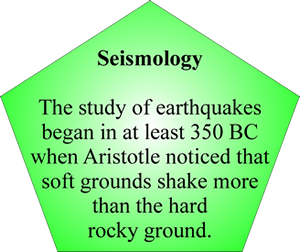
Theory: Birthstones are minerals or gems.
Actuality: Only 11 of the 12 birthstones are minerals. Minerals are naturally occurring substances with definite properties. The 12th, pearls, are not naturally occurring, they are produced biologically by mollusks.
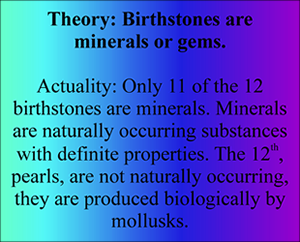
Theory: Concrete is a rock.
Actuality: Minerals are always considered naturally formed, whereas depending on the definition you look at, rocks don’t always have to be. So, in essence, sometimes concrete (and other non-natural rock/mineral conglomerates) can be considered rocks (from a certain point of view).

Theory: It is warmer in the summer because we are closer to the sun.
Actuality: Only the southern hemisphere is closer to the sun in their summer (Dec-Mar). The northern hemisphere is actually further away for theirs (Jun-Sept). The real reason for the warmer season is due to the angle of sunlight. When the northern hemisphere is pointed towards the sun, the sun is more directly overhead, and therefore it is warmer.
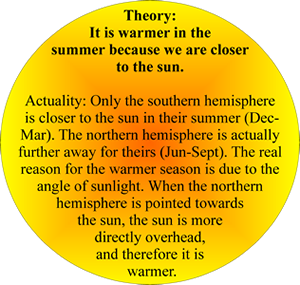
Myth: The only continent without a desert is Europe.
Actuality: Europe actually has a few areas, which may classify as a desert, specifically Almería. Also, a desert is determined by the amount of precipitation it gets (less than ~10 inches a year), not the temperature, and since there is very little precipitation in Antarctica, it ends up being the largest desert on Earth.
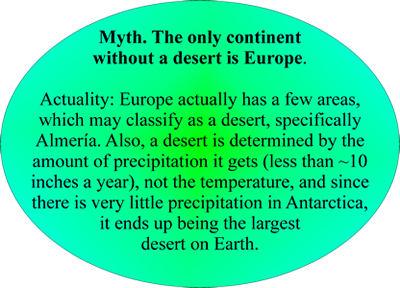
What is the Age of the Oldest Rock on Earth?
The oldest rock on Earth is a granite protolith that has been dated to 4.03 Ga (billion years). There are reports of a possibly older rock (a faux-amphibolite) dated up to 4.28 Ga, but there is some controversy about those rocks. Both of these rocks have been found in northern Canada.

Fossil Chalk
Naturally forming chalk is actually made up of millions of little fossils called coccoliths, which were the round “shells” of phytoplankton (a type of marine micro-plant) called coccolithophores.

